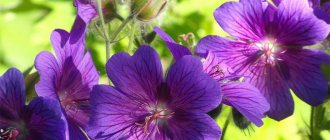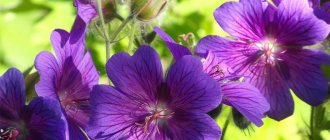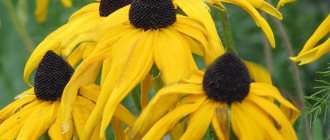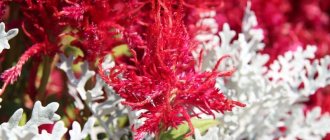Home » Flowers and plants » Flowers » Perennial flowers
Olga Polyakova 03/17/2020
9036 Views
Heuchera is a perennial belonging to the Saxifraga family. This plant is of North American origin; Most of its species grow in the wild in the United States, a small part of them in Mexico. A distinctive feature of heuchera is its decorative properties.
The color of the foliage of a plant can be very diverse: from standard green to extreme colors - red or silver. But that’s not all, since there are plants whose leaf colors combine several different colored shades. Heucheras are very popular among designers because they allow you to get a wide variety of colors for the lower level of flower beds and flower beds.
Below we discuss in detail the planting and care of heuchera, as well as photos of some varieties of the plant. The plant retains its attractive appearance from the first months of spring to the end of autumn. Its application in landscape design is extremely wide - from continuous cover plantings to border thickets on the sides of paths.
Landing
Choosing a landing site
This is a very important question because there is no clear answer to it. Adult plants do not tolerate life in sunny areas, preferring shade and partial shade, but this situation is contraindicated for young plants.
The growth rate of young plants in shaded areas is very low and you will have to wait a relatively long time to get beautiful bushes.
Heuchera in a flowerbed
Since the plant tolerates replanting and root separation well, it is recommended to plant the plants in the sun at the beginning of cultivation, and then plant adult plants in shaded areas. Therefore, if you purchase a plant with a developed root system, it sits in the shade.
When planting young or seed propagation of heuchera, planting should be done in a sunny area.
In addition, young animals do not tolerate cold winds well, so the place where they are planted should have protection at least from the north side.
All varieties of heuchera react very negatively to waterlogging of the root system, therefore, growing them in lowlands and any places with high groundwater levels is not recommended.
There is another recommendation for choosing a place for a plant, based on the color of its foliage. Varieties with lightly colored leaves (such as yellow, white or silver) will do well in sunny areas.
While darker ones (green, burgundy, raspberry and blue) grow much better in shading.
Soil for the plant
Heuchera comes from mountainous and rocky areas, where the soil has a predominantly neutral or slightly alkaline environment. Most of the soils of the European continent, if they differ from neutral, are in the direction of oxidation.
Therefore, the soil for heuchera requires liming. Depending on the acidity, liming with ash or dolomite flour can be used.
Dolomite flour is used for liming the soil
The plant does not like too heavy soils; light and well-water- and air-permeable soils are preferable. The plant also requires drainage. It is made from broken brick or large crushed stone; The thickness of the drainage layer must be at least 5 cm.
Planting seedlings
It is most preferable to plant seedlings in mid-spring . Seedlings can be purchased or obtained through vegetative propagation of the plant. In both cases, the measures for planting them are absolutely identical.
Heuchera seedlings
The procedure for planting seedlings is as follows:
1The stems of the plant must be trimmed to young tissue, and shoots that may have dried out should be cut to the level of living brood buds, which are usually located in the axils of the foliage.
2Preparation of the root system involves removing diseased, damaged or fungal-infected areas. Such parts of the root should be completely removed, and the sections should be treated with crushed charcoal.
3Planting is done in squares or in a checkerboard pattern. The distances between plants in a row and between rows are 50-60 cm.
4 A hole with a diameter and depth of 30 cm must be dug under each bush. A drainage system must be placed at its bottom, which is covered with a layer of soil of about 5 cm on top. Next, mineral or organic fertilizers are added to the soil. Nitroammophoska can be used as a mineral (no more than 15 g per plant). Organic matter can be a layer of humus or compost (about 3-4 cm).
5 A young seedling is placed in the center of the hole and covered with soil. The soil is slightly compacted and watered with 3-5 liters of water.
6For the first 2-3 days, it is advisable to shade the plant, after which the protection from direct sunlight is removed.
Planting heuchera seedlings
Complete rooting occurs approximately 40-45 days after planting. It is during this period that the plant can already be transplanted to a permanent place. However, there is no need to rush - it is best to do the transplant at the beginning of the next season.
Planting by seeds
Heuchera seeds
This is not the most common planting method, but with its help you can get a much larger amount of seed material at lower material costs. Growing heuchera through seedlings is quite simple and not burdensome. Moreover, its seeds, subject to storage conditions, have a germination rate close to 90%.
It is believed that the viability of seeds stored outdoors or in a paper bag is six months. The use of sealed packages or foil packages, which prevent access to the seeds not only of moisture, but also of light, extends this period to one and a half years.
After these deadlines, almost all seeds become unusable, so it is recommended to carefully check the dates of seed collection and packaging.
Sowing of seedlings usually occurs in late March or early April. Therefore, you should check whether the expiration dates of purchased seeds correspond to the planting dates.
The seedlings are planted in a box with drainage holes. The height of the box must be at least 5 cm. Any plastic container can be used as a container for growing, even cut off lower parts of large plastic bottles.
The main thing is to make drainage holes in them. It is also allowed to grow plants using peat tablets with a diameter of 27 or 36 mm.
Seedlings after germination
Seedlings require loose soil. Its composition is not of fundamental importance. It can even be ordinary garden soil, or a mixture consisting of equal proportions of peat, garden soil and sand.
If regular soil is used, it is recommended to mix it with a small amount of sand or perlite to improve its air and moisture permeability. The volume of sand or perlite is taken from 1/5 to 1/3 of the total volume of the soil mixture.
The soil must be thermally treated in order to kill the fungi in it. To do this, you should either pour boiling water over it, or place it in the oven for half an hour at a temperature of +110°C. After that, the soil must be dried for 24 hours and only then can you start planting the seeds.
Heuchera seeds are very small; sometimes it is recommended to mix them with sand when planting. The small size of the seeds does not mean they are buried in the ground. Therefore, after preliminary preparation of the soil, you should level its surface and moisten the top layer with a spray bottle.
Sowing is carried out directly on the soil surface. After which the box with seeds should be covered with glass or film.
Seeds require a large amount of light to germinate, so it is recommended to immediately place the box with them on the windowsill of a south-facing window. In this case, it is necessary that the temperature in this place be around + 18-20 ° C and there are no drafts.
Every day the box with seeds should be ventilated by removing the film or glass for 15 minutes. Watering should not be done daily, but as the soil dries. In about 15-20 days the seeds will sprout.
The film or glass should not be removed. They need to be raised a little; in some cases, several small holes are made in the film.
Picking seedlings is done when three true leaves appear on it . Seedlings are planted at distances of 4 to 6 cm between them. During this time, the soil should be kept moderately moist.
Seedlings picked into separate containers
Next, there are two options for further growing seedlings. Continue growing plants indoors or transplant them into open ground in a sunny area. Each of them has its own advantages and disadvantages.
Since a normal rosette is formed in heuchera within about one year, it is best to continue growing indoors. In this case, around June-July, the seedlings should be transplanted into larger boxes.
In the summer they can be taken out into the open air, or even remain there continuously until the end of the season, but with the onset of cold weather they are again placed indoors. The final planting of seedlings in open ground takes place in the spring of next year. This growing method is applicable in areas with harsh winters.
If cultivation takes place in milder conditions, it is possible to plant the plants in a sunny area in the garden already in mid-summer, corresponding to the year of planting. In this case, the plants will be better adapted for further cultivation.
However, in this case they will need to be covered for the winter with a layer of mulch about 10 cm thick. Peat, sawdust or compost should be used as mulch material.
Plant care
Mulched heuchera bushes
Directly maintaining heuchera in a healthy form does not require practically any action from the owner, since the flower, accustomed to growing in desert conditions, tolerates both summer and winter of temperate climates.
Watering should be seriously limited, since in fact even the level of natural precipitation in a temperate climate is excessive for heuchera.
To maintain the required level of moisture in the soil for a long time, it is recommended to mulch the soil around the plant with sawdust or pine needles in a layer of 3 to 5 cm. For mulched plants located in the shade, the amount of natural precipitation will be quite sufficient. Watering should only be done if the soil dries out excessively.
Plants located in open sunny areas should be watered at an average frequency of 1-2 times a week. To maintain soil moisture, mulching of such plants is mandatory.
Even poor soils for mature plants have a sufficient level of fertility. However, you should not completely ignore fertilizing: once a year, at the end of the season, it is recommended to mulch the plants after autumn pruning with a layer of peat or a mixture of peat and humus in a ratio of 1 to 1.
The above applies to decorative deciduous varieties of heuchera. There are also several dozen decorative flowering varieties. They require fertilizing with complex flower fertilizers before and after the flowering period.
Of all the procedures for caring for a plant, the procedures of pruning and loosening the soil remain the most relevant. The need for pruning in temperate climates increases significantly, since the abundant growth rate causes rapid growth of leaves. This leads to a strong thickening of the bushes and the plant simply becomes crowded.
Watering the plant before loosening
Typically pruning is done at the beginning and end of the season. The plant is actually evergreen and many of the leaves that appear in the second half of summer can easily survive the winter.
Pruning at the end of the season consists of removing diseased and damaged parts of the plant , as well as trimming excess side shoots and petioles that have lost leaves. But even old leaves are not removed during autumn pruning.
Removal of too old, as well as diseased and injured leaves is done in early spring. Also at this time, formative and stimulating pruning of the bush is performed.
Loosening the soil is important because the plant's root system needs a lot of air. The rocky soils of the plant’s homeland allow this process to proceed without problems, but in the heavy soils of the temperate zone the plant may have certain problems.
Typically, loosening is done once every 2-3 weeks. In this case, the soil in the area with heucheras is watered with a very small amount of water (to wet only a 2-3 cm layer at the surface) and loosened to the same depth.
Simultaneously with loosening, it is imperative to carry out the procedure of hilling the bushes, since the core of the bush is constantly sticking out of the ground. However, you shouldn’t be too zealous about this either.
The main thing in hilling is to cover the sockets to prevent them from drying out or frostbite.
When to plant heucheras in open ground: timing
It is best to plant heuchera in the spring, when the soil has already warmed up and the weather has improved and the threat of return frosts has passed. For example, in the central zone (Moscow region) these dates are May 15 - June 10. Or in the fall at the end of August, so that the plant takes root before the onset of frost.
In principle, you can plant heuchera in the summer, and replant it with a clod of earth and then shade the flowers. In general, container plants can be planted throughout the year.
According to the lunar calendar 2022
The optimal landing time can be selected according to the 2019 Lunar calendar:
- March - 12-17, 19-20, 27-30;
- April – 6-8, 11-13,15-17,24-26,29,30;
- May – 6-8, 10-17, 21-23, 26-28,31;
- June – 1-2, 5, 6, 9-13, 16-30, excluding 21-26;
- July - 8-12, 25-31;
- August - 2-6, 17-18, 21-28, excluding 24 and 25;
- September - 1-5, 7-10, 17-24;
- October - 4-7, 9-12, 19-21, 23-25, and 27;
- November - 13-18.
However, there are also unfavorable days for planting:
- March – 6,7,21;
- April – 5.19;
- May – 5.19;
- June -3,4,17;
- July - 2, 3, 17;
- August - 15, 16, 30, 31;
- September - 14, 15, 28, 29;
- October - 14, 28;
- November - 12, 13, 26, 27.
Transfer
For some species, replanting heuchera is necessary every three years. The plant retains its rosette for no more than five years. Then the bush exposes the entire middle. The plant can be replanted in autumn or spring. To plant a plant, you need to do the following steps:
- After flowering ends, remove flower stalks and bare stems. The plant blooms from June to August. Her flowers are small. The color can be cream, white, red, bloody, purple. The flowers look like bells. They are collected in panicles. The fruit of heuchera is a capsule in which the seeds are located. They are the size of a poppy seed.
- Dig up an old bush and divide it into several parts.
- Plant the resulting divisions according to the selected locations.
Features of cultivation
There are no obvious features or difficulties in growing heuchera, but this plant has characteristic features that will not hurt you to know. So:
- for decorative deciduous varieties of heuchera, if you do not have the goal of collecting seeds in the fall, it is better to remove the peduncle as soon as it appears: they grow much higher than the bush and have an unkempt appearance, which damages the decorative qualities of the plant;
- peduncles of decorative flowering varieties are removed immediately after the heuchera fades;
- Over time, the lower leaves on the bush fall off, and the heuchera looks untidy. You need to dig up the plant before flowering and transplant it together with the earthen ball into a deeper hole to hide the bald stem;
- at the beginning of growth, young heuchera leaves are bright and translucent, like flower petals, but as they mature, they thicken and darken;
- Heuchera goes well with primroses, daylilies, astilbe, bergenia and ornamental cereals.
In the photo: Variegated leaves of heuchera
What problems might you encounter?
As a rule, gardeners do not have any particular problems with heucheras. The most common possible difficulty may be poor shrub growth. In such cases, it is recommended to change the planting location, try partial shade or planting on stones on which the culture is actively developing. You can take care of fertilizing the soil and add compost to it.
Hoya flower - what the varieties Carnosa, Kerry, Bella, fleshy, multiflora look like
If you properly care for the flower, there will be no problems with it. The culture needs rejuvenation and division of the bush. Therefore, when the roots grow strongly and the foliage begins to dry out, it is worth taking care of replanting.
Note! Not all plant species like the same growing conditions. For example, by its color they determine what kind of lighting is required. For a novice gardener, it is better to choose a green shade of the leaf. It will not fade in the sun, and will not wither in the shade.
Selecting a location
The importance of choosing a location even for such an unpretentious plant is very high. It depends on how correctly it is selected:
Original design of the front entrance to the house. Arrays of greenery create a very cozy atmosphere in the yard
- brightness of leaves;
- abundance of flowering;
- duration of preservation of decorative properties.
You can combine heucheras of different types, varieties and colors, creating unique compositions
Note! In some sources you can see quite controversial recommendations. Some say - in the sun, others say - only in the shade. To a large extent it depends on the species.
Thanks to the versatility of heuchera, you can create multi-tiered compositions from this plant
A general recommendation that will not make the plant worse is to choose a semi-shaded area where the sun hits in the morning. If the plant is young and fragile, then it needs more sun. The best place for it is the east or west side.
With sufficient light, the leaves of the heuchera will turn colors corresponding to the species, but if the plant is constantly in the shade, it will remain green
Important! If there is no other area other than a sunny one, heuchera needs regular and abundant watering. And, by the way, varieties with red leaves will get their characteristic color only if they grow in the sun, otherwise they will remain green.
A lush burgundy heuchera bush will shine in the sun with all the shades of its color palette
Heuchera will thank you for its light and nutritious soil. With good drainage and water permeability. If the snow does not melt on the site for a long time, and puddles form after rain, it is better not to plant this plant in them. The result will be root rot and disease or death of the plant.
Another, quite interesting, option for multi-tiered design of space in the courtyard of a private house
Color harmony in landscape design
If heuchera was once in the role of Cinderella in the flowerbed, today it is leading the list of candidates for decorating the flower area. The varieties bred by breeders never cease to amaze lovers of gardening creativity. Therefore, the magnificent plant, heuchera, has taken its place of honor in landscape design.
It can be seen in various green compositions:
- flower and shrub mixborders;
- in the company of proud roses, irises, ferns and lilies;
- in combination with tulips, crocuses and daffodils, geraniums and hostas;
- when forming rock gardens;
- for decorating borders;
- in container versions on the garden plot (gazebos, terraces);
- for the design of coastal zones of artificial reservoirs.
The bright leaves of heuchera serve as an indispensable accent to the green garden throughout the season. They are used for a harmonious transition from plant to plant. Thus, the emptiness of the site is completely filled during the flower off-season.
Heuchera does not require special care. Does well in sun and shady places. Frost-resistant. Easily propagated. Not sick.
In the photo shown, the heuchera looks wonderful in the company of its relatives. The variety of shades of its leaves allows you to create a motley multi-colored corner on the site.
Many gardeners have noted that working with heuchera is a pleasure. It blends harmoniously with any plants in the garden and always looks royal.
Heuchera pests and diseases
Heucheras do not get sick often, and if this happens, the situation is not critical. The main thing is not to overfeed the plant and thoroughly drain the soil, because otherwise the perennial becomes weaker and does not resist disease.
If powdery mildew appears on the leaves or root rot, then dig up the perennial and treat it with a fungicide; it won’t hurt to replant it in another place. And if affected by spotting or rust, spray with a solution of Bordeaux mixture once every two weeks until complete recovery. As for pests, you can use insecticides against snails, caterpillars, and leaf nematodes.
Plant propagation
There are three main methods of propagation of heuchera : two of them are vegetative - by dividing the bush and cuttings, and one is by seed. The latter was discussed in detail earlier in the landing section. Now let's turn our attention to the vegetative propagation of heuchera.
Dividing the bush
Excessively thickened heuchera bush
By dividing the bush Once every 3-4 years, the plant must be replanted to avoid excessive thickening of its root system and leaf rosettes. Typically, the operation to divide the bush is carried out either in early May or in mid-August. For this purpose, the bush should be dug out of the ground without damaging its root system, and its structure should be carefully examined.
It should be said right away that you should not leave large groups of rosettes, since the bush will have to be replanted next year . It is necessary to properly divide the bush, leaving 2-3 leafy rosettes in each plot.
The division should occur in such a way that the rosettes falling into each plot are located on the same rhizome. When dividing, use a knife or pruning shears disinfected in alcohol, and sprinkle the cut areas with crushed charcoal powder or cinnamon.
Also, during the division of the bush, its root system is sanitized - excessively long, dry and damaged roots are removed from it.
Further work with seedlings was described earlier. We just have to remind you again that in the first year of independent life, it is best to plant a seedling not in a permanent place, but in a special bed for young animals, located in a sunny area. Thus, the plant can quickly form new rosettes and leaves in just one season.
Cuttings
Heuchera root cuttings
Cuttings This method is simpler and not as radical as dividing a bush. It can be applied to plants of almost any age. The essence of this method is that only a rosette with a small part of the root is cut off from the mother bush, after which it takes root in ordinary soil into which young seedlings are planted.
To ensure the guaranteed appearance of roots in such a cutting, it can be placed in a nutritious sand-peat substrate . As a last resort, you can place the cuttings in ordinary water, diluted with rooting agents and stimulants like Epin.
Usually, the roots of the cuttings appear after 3-4 weeks . After which they are transplanted to a sunny area. Plants that were immediately planted in the ground should be protected during rooting with improvised greenhouses made from plastic bottles.
Rooting lateral cuttings
Spotted plants are propagated in this way to preserve their unique leaf patterns. Choose a plant with the color you like, find above-ground shoots with buds, cut them and transfer them to a greenhouse or seedling bed.
Treat the branches with a root stimulator according to the instructions for the product. Then plant shallowly so that the buds of new shoots rise above ground level. After 3 weeks, the cuttings will take root; after 1.5-2 months, transplant the young bushes.











